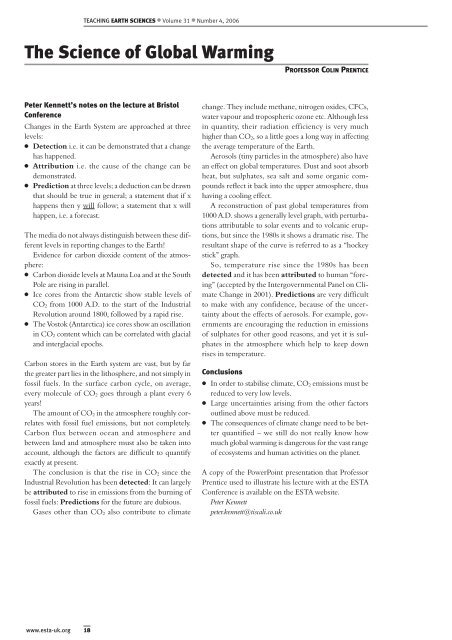teaching - Earth Science Teachers' Association
teaching - Earth Science Teachers' Association
teaching - Earth Science Teachers' Association
You also want an ePaper? Increase the reach of your titles
YUMPU automatically turns print PDFs into web optimized ePapers that Google loves.
TEACHING EARTH SCIENCES ● Volume 31 ● Number 4, 2006<br />
The <strong>Science</strong> of Global Warming<br />
PROFESSOR COLIN PRENTICE<br />
Peter Kennett’s notes on the lecture at Bristol<br />
Conference<br />
Changes in the <strong>Earth</strong> System are approached at three<br />
levels:<br />
● Detection i.e. it can be demonstrated that a change<br />
has happened.<br />
● Attribution i.e. the cause of the change can be<br />
demonstrated.<br />
● Prediction at three levels; a deduction can be drawn<br />
that should be true in general; a statement that if x<br />
happens then y will follow; a statement that x will<br />
happen, i.e. a forecast.<br />
The media do not always distinguish between these different<br />
levels in reporting changes to the <strong>Earth</strong>!<br />
Evidence for carbon dioxide content of the atmosphere:<br />
● Carbon dioxide levels at Mauna Loa and at the South<br />
Pole are rising in parallel.<br />
● Ice cores from the Antarctic show stable levels of<br />
CO 2 from 1000 A.D. to the start of the Industrial<br />
Revolution around 1800, followed by a rapid rise.<br />
● The Vostok (Antarctica) ice cores show an oscillation<br />
in CO 2 content which can be correlated with glacial<br />
and interglacial epochs.<br />
Carbon stores in the <strong>Earth</strong> system are vast, but by far<br />
the greater part lies in the lithosphere, and not simply in<br />
fossil fuels. In the surface carbon cycle, on average,<br />
every molecule of CO 2 goes through a plant every 6<br />
years!<br />
The amount of CO 2 in the atmosphere roughly correlates<br />
with fossil fuel emissions, but not completely.<br />
Carbon flux between ocean and atmosphere and<br />
between land and atmosphere must also be taken into<br />
account, although the factors are difficult to quantify<br />
exactly at present.<br />
The conclusion is that the rise in CO 2 since the<br />
Industrial Revolution has been detected: It can largely<br />
be attributed to rise in emissions from the burning of<br />
fossil fuels: Predictions for the future are dubious.<br />
Gases other than CO 2 also contribute to climate<br />
change. They include methane, nitrogen oxides, CFCs,<br />
water vapour and tropospheric ozone etc. Although less<br />
in quantity, their radiation efficiency is very much<br />
higher than CO 2 , so a little goes a long way in affecting<br />
the average temperature of the <strong>Earth</strong>.<br />
Aerosols (tiny particles in the atmosphere) also have<br />
an effect on global temperatures. Dust and soot absorb<br />
heat, but sulphates, sea salt and some organic compounds<br />
reflect it back into the upper atmosphere, thus<br />
having a cooling effect.<br />
A reconstruction of past global temperatures from<br />
1000 A.D. shows a generally level graph, with perturbations<br />
attributable to solar events and to volcanic eruptions,<br />
but since the 1980s it shows a dramatic rise. The<br />
resultant shape of the curve is referred to as a “hockey<br />
stick” graph.<br />
So, temperature rise since the 1980s has been<br />
detected and it has been attributed to human “forcing”<br />
(accepted by the Intergovernmental Panel on Climate<br />
Change in 2001). Predictions are very difficult<br />
to make with any confidence, because of the uncertainty<br />
about the effects of aerosols. For example, governments<br />
are encouraging the reduction in emissions<br />
of sulphates for other good reasons, and yet it is sulphates<br />
in the atmosphere which help to keep down<br />
rises in temperature.<br />
Conclusions<br />
● In order to stabilise climate, CO 2 emissions must be<br />
reduced to very low levels.<br />
● Large uncertainties arising from the other factors<br />
outlined above must be reduced.<br />
● The consequences of climate change need to be better<br />
quantified – we still do not really know how<br />
much global warming is dangerous for the vast range<br />
of ecosystems and human activities on the planet.<br />
A copy of the PowerPoint presentation that Professor<br />
Prentice used to illustrate his lecture with at the ESTA<br />
Conference is available on the ESTA website.<br />
Peter Kennett<br />
peter.kennett@tiscali.co.uk<br />
www.esta-uk.org<br />
18

















